Risk Management Report: Capital Management System for Fortune 500
VerifiedAdded on 2023/06/09
|12
|2372
|78
Report
AI Summary
This report focuses on risk management within an Information Security (IS) project aimed at establishing a new Capital Management System (CMS) for a Fortune 500 company. The report begins with an introduction to risk management, defining it as the process of identifying potential risks, assessing their probability and severity, and planning responses. The project's objectives include creating a customized internet-based software package for capital budget management, with key goals of completing the project within budget, functionality, and schedule. The discussion section covers risk identification, including techniques like brainstorming, checklists, interviews, and flowcharts. It identifies various risks, such as loss of key personnel, cost underestimates, and data-related issues, along with their causes and potential impacts. The report then details risk mitigation and contingency plans, emphasizing the importance of reducing the expected value of risk events through impact and probability reduction. It outlines mitigation strategies for each identified risk and includes contingency plans. Finally, the report addresses residual risks and their mitigation, concluding that effective risk management is crucial for the project's success, ensuring completion within the estimated time and cost. The references cited support the methodologies and strategies discussed.

Running head: RISK MANAGEMENT
Risk Management
[Name of the Student]
[Name of the University]
[Author note]
Risk Management
[Name of the Student]
[Name of the University]
[Author note]
Paraphrase This Document
Need a fresh take? Get an instant paraphrase of this document with our AI Paraphraser
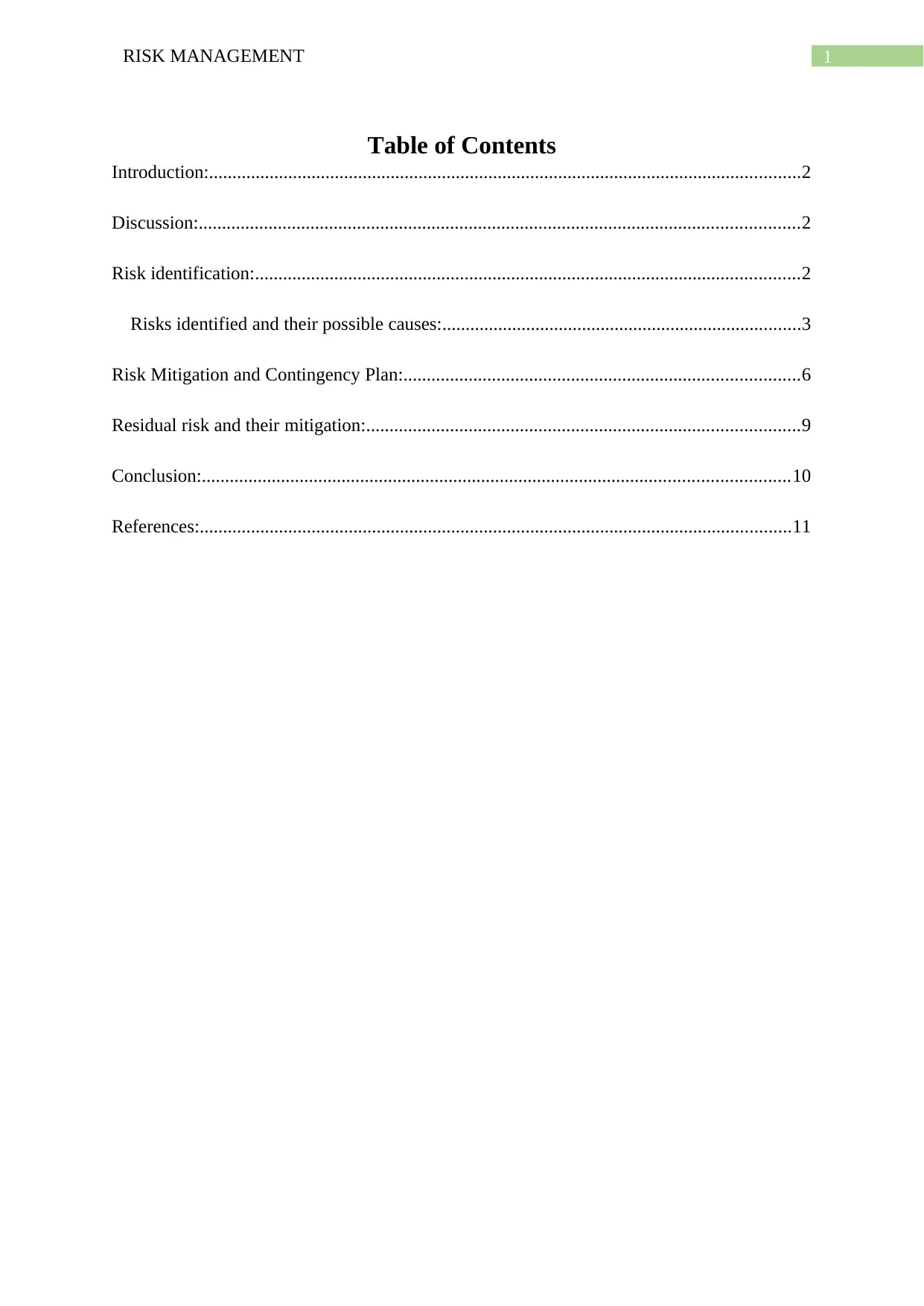
1RISK MANAGEMENT
Table of Contents
Introduction:...............................................................................................................................2
Discussion:.................................................................................................................................2
Risk identification:.....................................................................................................................2
Risks identified and their possible causes:.............................................................................3
Risk Mitigation and Contingency Plan:.....................................................................................6
Residual risk and their mitigation:.............................................................................................9
Conclusion:..............................................................................................................................10
References:...............................................................................................................................11
Table of Contents
Introduction:...............................................................................................................................2
Discussion:.................................................................................................................................2
Risk identification:.....................................................................................................................2
Risks identified and their possible causes:.............................................................................3
Risk Mitigation and Contingency Plan:.....................................................................................6
Residual risk and their mitigation:.............................................................................................9
Conclusion:..............................................................................................................................10
References:...............................................................................................................................11
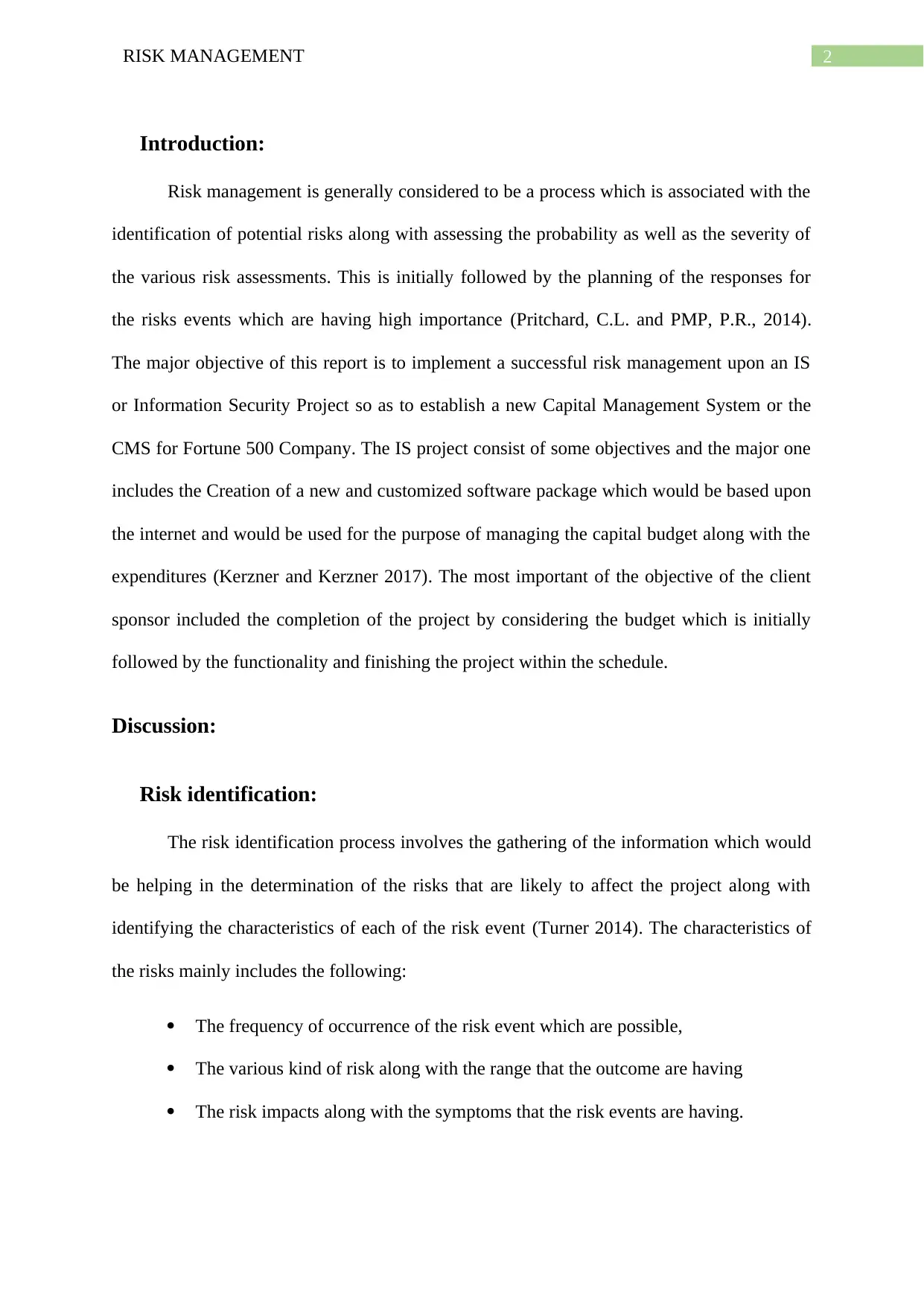
2RISK MANAGEMENT
Introduction:
Risk management is generally considered to be a process which is associated with the
identification of potential risks along with assessing the probability as well as the severity of
the various risk assessments. This is initially followed by the planning of the responses for
the risks events which are having high importance (Pritchard, C.L. and PMP, P.R., 2014).
The major objective of this report is to implement a successful risk management upon an IS
or Information Security Project so as to establish a new Capital Management System or the
CMS for Fortune 500 Company. The IS project consist of some objectives and the major one
includes the Creation of a new and customized software package which would be based upon
the internet and would be used for the purpose of managing the capital budget along with the
expenditures (Kerzner and Kerzner 2017). The most important of the objective of the client
sponsor included the completion of the project by considering the budget which is initially
followed by the functionality and finishing the project within the schedule.
Discussion:
Risk identification:
The risk identification process involves the gathering of the information which would
be helping in the determination of the risks that are likely to affect the project along with
identifying the characteristics of each of the risk event (Turner 2014). The characteristics of
the risks mainly includes the following:
The frequency of occurrence of the risk event which are possible,
The various kind of risk along with the range that the outcome are having
The risk impacts along with the symptoms that the risk events are having.
Introduction:
Risk management is generally considered to be a process which is associated with the
identification of potential risks along with assessing the probability as well as the severity of
the various risk assessments. This is initially followed by the planning of the responses for
the risks events which are having high importance (Pritchard, C.L. and PMP, P.R., 2014).
The major objective of this report is to implement a successful risk management upon an IS
or Information Security Project so as to establish a new Capital Management System or the
CMS for Fortune 500 Company. The IS project consist of some objectives and the major one
includes the Creation of a new and customized software package which would be based upon
the internet and would be used for the purpose of managing the capital budget along with the
expenditures (Kerzner and Kerzner 2017). The most important of the objective of the client
sponsor included the completion of the project by considering the budget which is initially
followed by the functionality and finishing the project within the schedule.
Discussion:
Risk identification:
The risk identification process involves the gathering of the information which would
be helping in the determination of the risks that are likely to affect the project along with
identifying the characteristics of each of the risk event (Turner 2014). The characteristics of
the risks mainly includes the following:
The frequency of occurrence of the risk event which are possible,
The various kind of risk along with the range that the outcome are having
The risk impacts along with the symptoms that the risk events are having.
⊘ This is a preview!⊘
Do you want full access?
Subscribe today to unlock all pages.

Trusted by 1+ million students worldwide
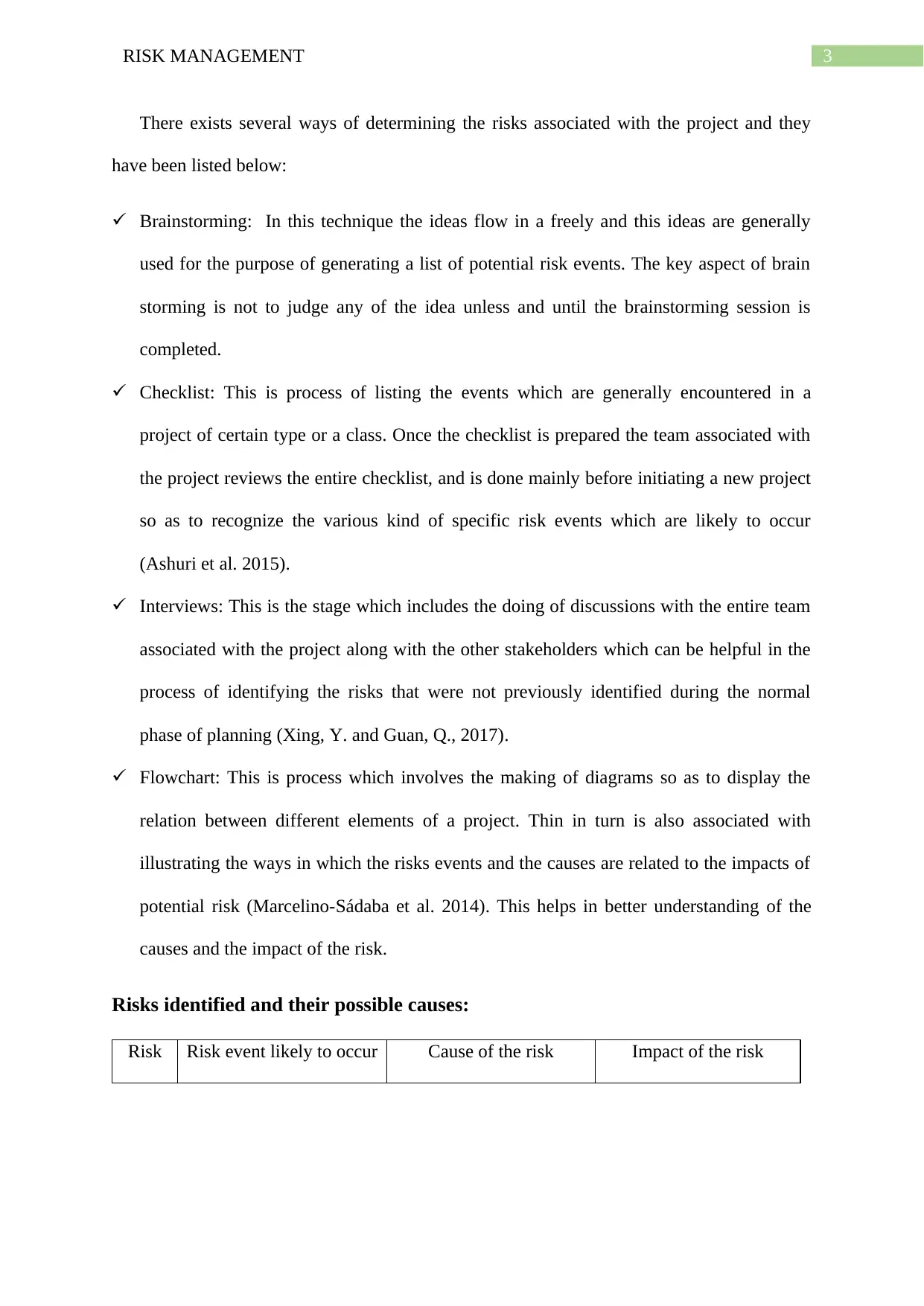
3RISK MANAGEMENT
There exists several ways of determining the risks associated with the project and they
have been listed below:
Brainstorming: In this technique the ideas flow in a freely and this ideas are generally
used for the purpose of generating a list of potential risk events. The key aspect of brain
storming is not to judge any of the idea unless and until the brainstorming session is
completed.
Checklist: This is process of listing the events which are generally encountered in a
project of certain type or a class. Once the checklist is prepared the team associated with
the project reviews the entire checklist, and is done mainly before initiating a new project
so as to recognize the various kind of specific risk events which are likely to occur
(Ashuri et al. 2015).
Interviews: This is the stage which includes the doing of discussions with the entire team
associated with the project along with the other stakeholders which can be helpful in the
process of identifying the risks that were not previously identified during the normal
phase of planning (Xing, Y. and Guan, Q., 2017).
Flowchart: This is process which involves the making of diagrams so as to display the
relation between different elements of a project. Thin in turn is also associated with
illustrating the ways in which the risks events and the causes are related to the impacts of
potential risk (Marcelino-Sádaba et al. 2014). This helps in better understanding of the
causes and the impact of the risk.
Risks identified and their possible causes:
Risk Risk event likely to occur Cause of the risk Impact of the risk
There exists several ways of determining the risks associated with the project and they
have been listed below:
Brainstorming: In this technique the ideas flow in a freely and this ideas are generally
used for the purpose of generating a list of potential risk events. The key aspect of brain
storming is not to judge any of the idea unless and until the brainstorming session is
completed.
Checklist: This is process of listing the events which are generally encountered in a
project of certain type or a class. Once the checklist is prepared the team associated with
the project reviews the entire checklist, and is done mainly before initiating a new project
so as to recognize the various kind of specific risk events which are likely to occur
(Ashuri et al. 2015).
Interviews: This is the stage which includes the doing of discussions with the entire team
associated with the project along with the other stakeholders which can be helpful in the
process of identifying the risks that were not previously identified during the normal
phase of planning (Xing, Y. and Guan, Q., 2017).
Flowchart: This is process which involves the making of diagrams so as to display the
relation between different elements of a project. Thin in turn is also associated with
illustrating the ways in which the risks events and the causes are related to the impacts of
potential risk (Marcelino-Sádaba et al. 2014). This helps in better understanding of the
causes and the impact of the risk.
Risks identified and their possible causes:
Risk Risk event likely to occur Cause of the risk Impact of the risk
Paraphrase This Document
Need a fresh take? Get an instant paraphrase of this document with our AI Paraphraser
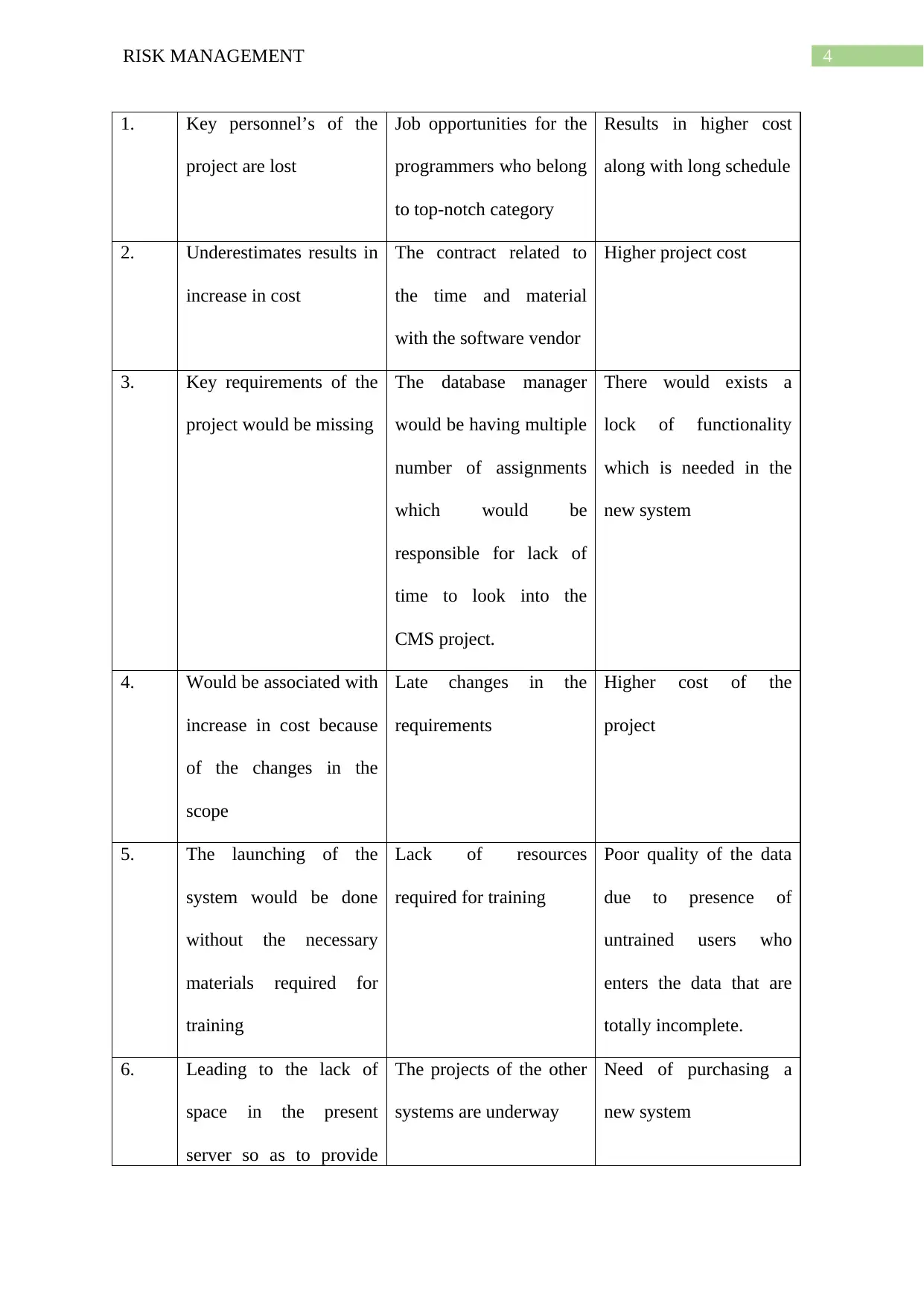
4RISK MANAGEMENT
1. Key personnel’s of the
project are lost
Job opportunities for the
programmers who belong
to top-notch category
Results in higher cost
along with long schedule
2. Underestimates results in
increase in cost
The contract related to
the time and material
with the software vendor
Higher project cost
3. Key requirements of the
project would be missing
The database manager
would be having multiple
number of assignments
which would be
responsible for lack of
time to look into the
CMS project.
There would exists a
lock of functionality
which is needed in the
new system
4. Would be associated with
increase in cost because
of the changes in the
scope
Late changes in the
requirements
Higher cost of the
project
5. The launching of the
system would be done
without the necessary
materials required for
training
Lack of resources
required for training
Poor quality of the data
due to presence of
untrained users who
enters the data that are
totally incomplete.
6. Leading to the lack of
space in the present
server so as to provide
The projects of the other
systems are underway
Need of purchasing a
new system
1. Key personnel’s of the
project are lost
Job opportunities for the
programmers who belong
to top-notch category
Results in higher cost
along with long schedule
2. Underestimates results in
increase in cost
The contract related to
the time and material
with the software vendor
Higher project cost
3. Key requirements of the
project would be missing
The database manager
would be having multiple
number of assignments
which would be
responsible for lack of
time to look into the
CMS project.
There would exists a
lock of functionality
which is needed in the
new system
4. Would be associated with
increase in cost because
of the changes in the
scope
Late changes in the
requirements
Higher cost of the
project
5. The launching of the
system would be done
without the necessary
materials required for
training
Lack of resources
required for training
Poor quality of the data
due to presence of
untrained users who
enters the data that are
totally incomplete.
6. Leading to the lack of
space in the present
server so as to provide
The projects of the other
systems are underway
Need of purchasing a
new system
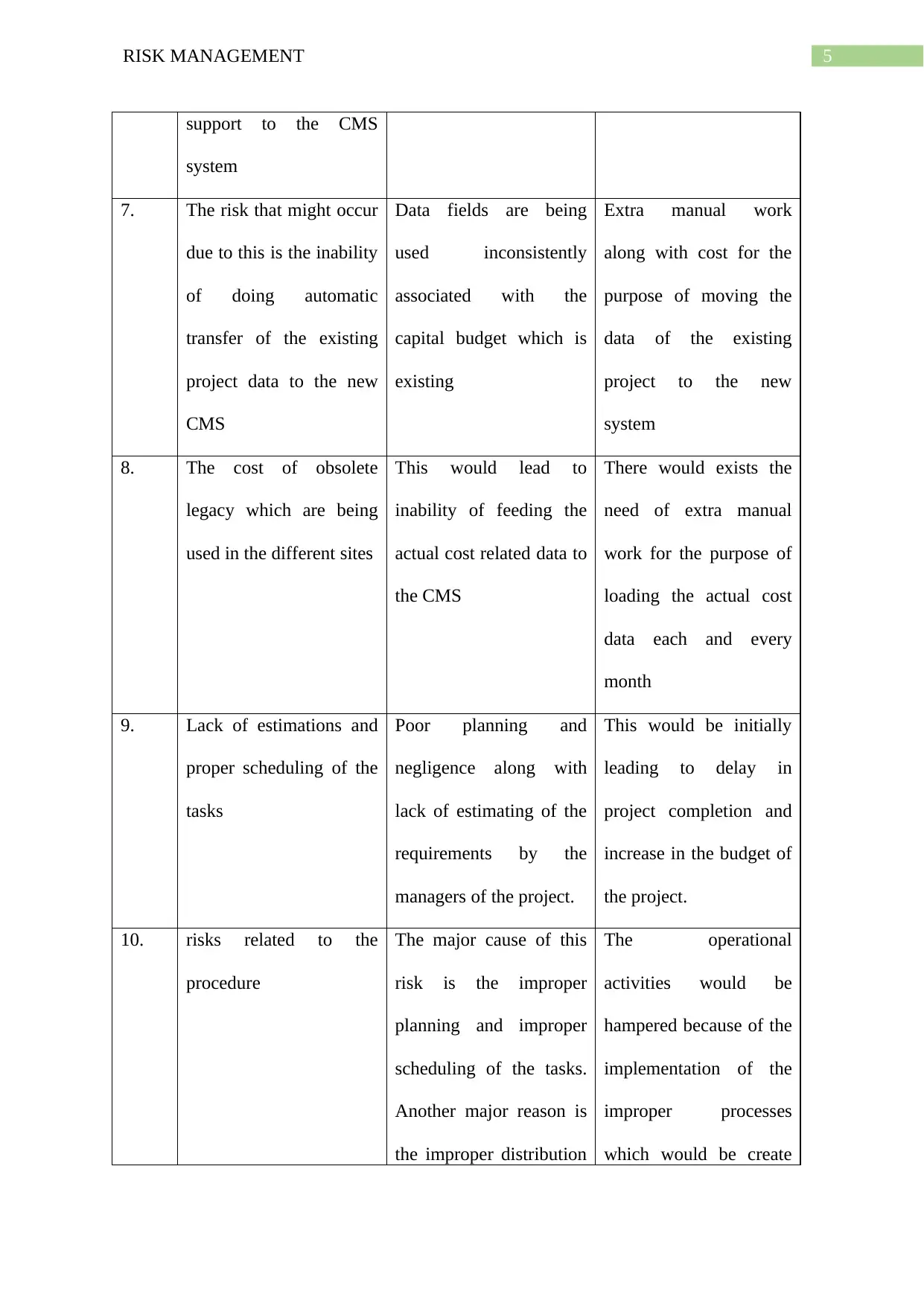
5RISK MANAGEMENT
support to the CMS
system
7. The risk that might occur
due to this is the inability
of doing automatic
transfer of the existing
project data to the new
CMS
Data fields are being
used inconsistently
associated with the
capital budget which is
existing
Extra manual work
along with cost for the
purpose of moving the
data of the existing
project to the new
system
8. The cost of obsolete
legacy which are being
used in the different sites
This would lead to
inability of feeding the
actual cost related data to
the CMS
There would exists the
need of extra manual
work for the purpose of
loading the actual cost
data each and every
month
9. Lack of estimations and
proper scheduling of the
tasks
Poor planning and
negligence along with
lack of estimating of the
requirements by the
managers of the project.
This would be initially
leading to delay in
project completion and
increase in the budget of
the project.
10. risks related to the
procedure
The major cause of this
risk is the improper
planning and improper
scheduling of the tasks.
Another major reason is
the improper distribution
The operational
activities would be
hampered because of the
implementation of the
improper processes
which would be create
support to the CMS
system
7. The risk that might occur
due to this is the inability
of doing automatic
transfer of the existing
project data to the new
CMS
Data fields are being
used inconsistently
associated with the
capital budget which is
existing
Extra manual work
along with cost for the
purpose of moving the
data of the existing
project to the new
system
8. The cost of obsolete
legacy which are being
used in the different sites
This would lead to
inability of feeding the
actual cost related data to
the CMS
There would exists the
need of extra manual
work for the purpose of
loading the actual cost
data each and every
month
9. Lack of estimations and
proper scheduling of the
tasks
Poor planning and
negligence along with
lack of estimating of the
requirements by the
managers of the project.
This would be initially
leading to delay in
project completion and
increase in the budget of
the project.
10. risks related to the
procedure
The major cause of this
risk is the improper
planning and improper
scheduling of the tasks.
Another major reason is
the improper distribution
The operational
activities would be
hampered because of the
implementation of the
improper processes
which would be create
⊘ This is a preview!⊘
Do you want full access?
Subscribe today to unlock all pages.

Trusted by 1+ million students worldwide
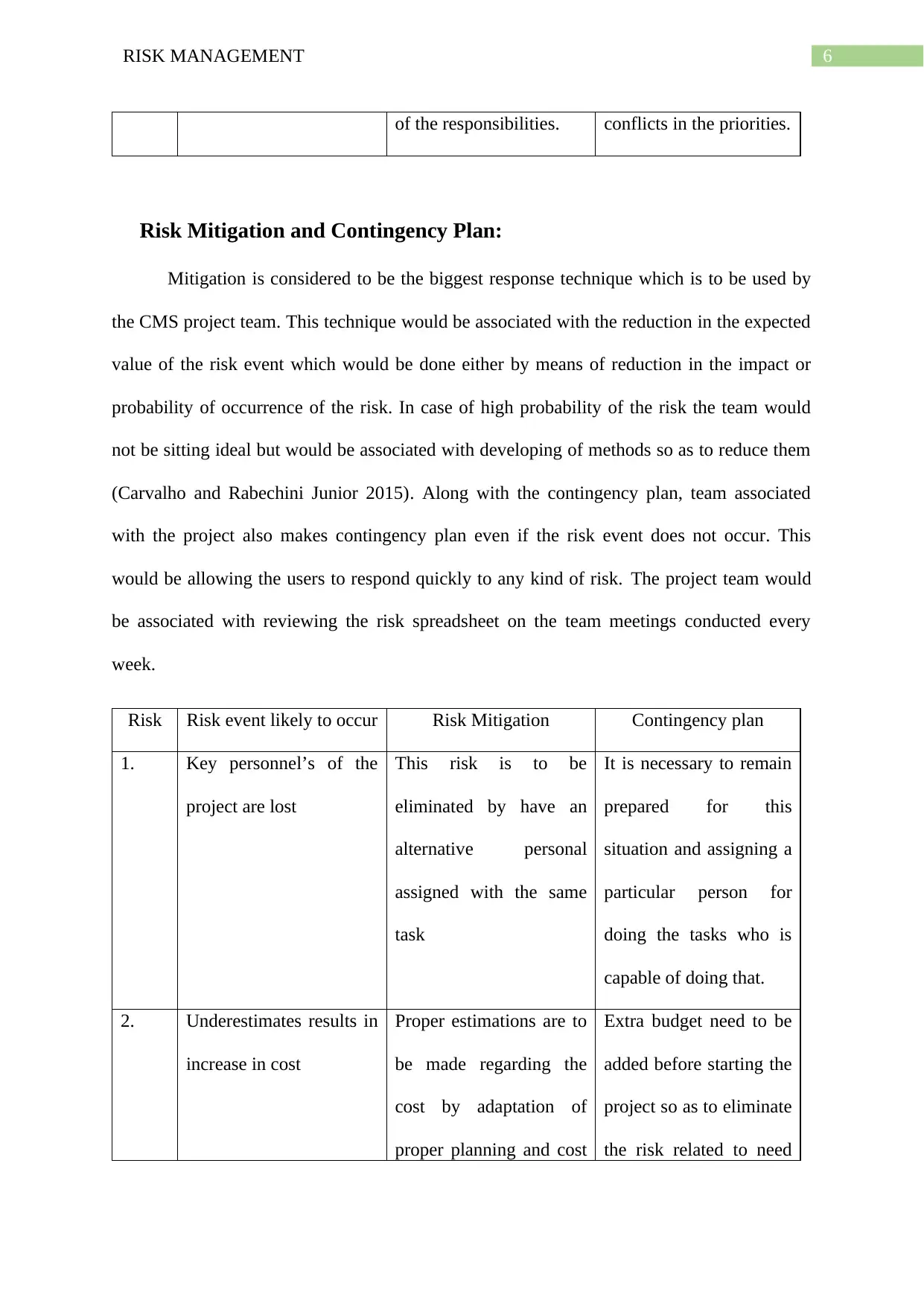
6RISK MANAGEMENT
of the responsibilities. conflicts in the priorities.
Risk Mitigation and Contingency Plan:
Mitigation is considered to be the biggest response technique which is to be used by
the CMS project team. This technique would be associated with the reduction in the expected
value of the risk event which would be done either by means of reduction in the impact or
probability of occurrence of the risk. In case of high probability of the risk the team would
not be sitting ideal but would be associated with developing of methods so as to reduce them
(Carvalho and Rabechini Junior 2015). Along with the contingency plan, team associated
with the project also makes contingency plan even if the risk event does not occur. This
would be allowing the users to respond quickly to any kind of risk. The project team would
be associated with reviewing the risk spreadsheet on the team meetings conducted every
week.
Risk Risk event likely to occur Risk Mitigation Contingency plan
1. Key personnel’s of the
project are lost
This risk is to be
eliminated by have an
alternative personal
assigned with the same
task
It is necessary to remain
prepared for this
situation and assigning a
particular person for
doing the tasks who is
capable of doing that.
2. Underestimates results in
increase in cost
Proper estimations are to
be made regarding the
cost by adaptation of
proper planning and cost
Extra budget need to be
added before starting the
project so as to eliminate
the risk related to need
of the responsibilities. conflicts in the priorities.
Risk Mitigation and Contingency Plan:
Mitigation is considered to be the biggest response technique which is to be used by
the CMS project team. This technique would be associated with the reduction in the expected
value of the risk event which would be done either by means of reduction in the impact or
probability of occurrence of the risk. In case of high probability of the risk the team would
not be sitting ideal but would be associated with developing of methods so as to reduce them
(Carvalho and Rabechini Junior 2015). Along with the contingency plan, team associated
with the project also makes contingency plan even if the risk event does not occur. This
would be allowing the users to respond quickly to any kind of risk. The project team would
be associated with reviewing the risk spreadsheet on the team meetings conducted every
week.
Risk Risk event likely to occur Risk Mitigation Contingency plan
1. Key personnel’s of the
project are lost
This risk is to be
eliminated by have an
alternative personal
assigned with the same
task
It is necessary to remain
prepared for this
situation and assigning a
particular person for
doing the tasks who is
capable of doing that.
2. Underestimates results in
increase in cost
Proper estimations are to
be made regarding the
cost by adaptation of
proper planning and cost
Extra budget need to be
added before starting the
project so as to eliminate
the risk related to need
Paraphrase This Document
Need a fresh take? Get an instant paraphrase of this document with our AI Paraphraser
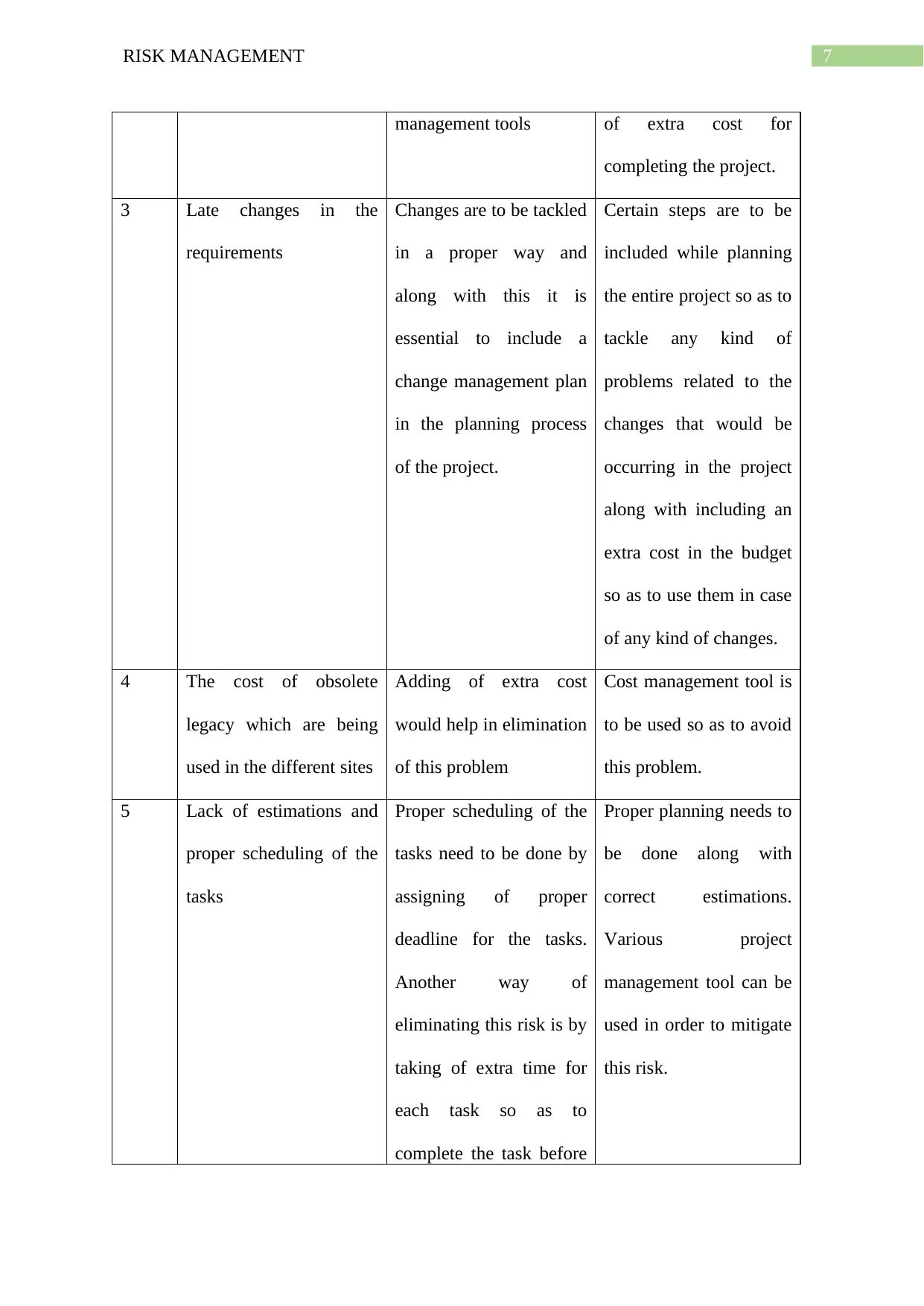
7RISK MANAGEMENT
management tools of extra cost for
completing the project.
3 Late changes in the
requirements
Changes are to be tackled
in a proper way and
along with this it is
essential to include a
change management plan
in the planning process
of the project.
Certain steps are to be
included while planning
the entire project so as to
tackle any kind of
problems related to the
changes that would be
occurring in the project
along with including an
extra cost in the budget
so as to use them in case
of any kind of changes.
4 The cost of obsolete
legacy which are being
used in the different sites
Adding of extra cost
would help in elimination
of this problem
Cost management tool is
to be used so as to avoid
this problem.
5 Lack of estimations and
proper scheduling of the
tasks
Proper scheduling of the
tasks need to be done by
assigning of proper
deadline for the tasks.
Another way of
eliminating this risk is by
taking of extra time for
each task so as to
complete the task before
Proper planning needs to
be done along with
correct estimations.
Various project
management tool can be
used in order to mitigate
this risk.
management tools of extra cost for
completing the project.
3 Late changes in the
requirements
Changes are to be tackled
in a proper way and
along with this it is
essential to include a
change management plan
in the planning process
of the project.
Certain steps are to be
included while planning
the entire project so as to
tackle any kind of
problems related to the
changes that would be
occurring in the project
along with including an
extra cost in the budget
so as to use them in case
of any kind of changes.
4 The cost of obsolete
legacy which are being
used in the different sites
Adding of extra cost
would help in elimination
of this problem
Cost management tool is
to be used so as to avoid
this problem.
5 Lack of estimations and
proper scheduling of the
tasks
Proper scheduling of the
tasks need to be done by
assigning of proper
deadline for the tasks.
Another way of
eliminating this risk is by
taking of extra time for
each task so as to
complete the task before
Proper planning needs to
be done along with
correct estimations.
Various project
management tool can be
used in order to mitigate
this risk.
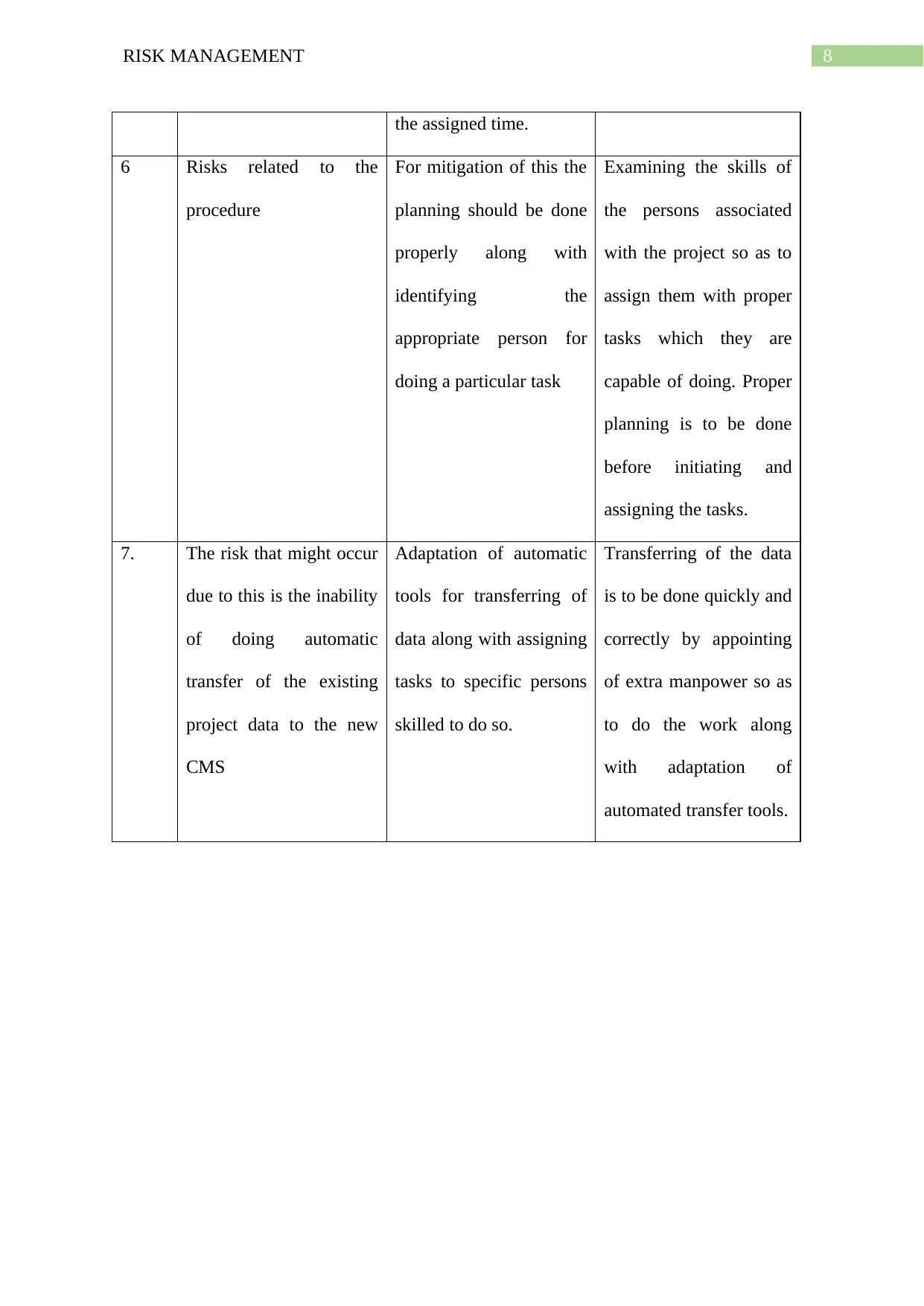
8RISK MANAGEMENT
the assigned time.
6 Risks related to the
procedure
For mitigation of this the
planning should be done
properly along with
identifying the
appropriate person for
doing a particular task
Examining the skills of
the persons associated
with the project so as to
assign them with proper
tasks which they are
capable of doing. Proper
planning is to be done
before initiating and
assigning the tasks.
7. The risk that might occur
due to this is the inability
of doing automatic
transfer of the existing
project data to the new
CMS
Adaptation of automatic
tools for transferring of
data along with assigning
tasks to specific persons
skilled to do so.
Transferring of the data
is to be done quickly and
correctly by appointing
of extra manpower so as
to do the work along
with adaptation of
automated transfer tools.
the assigned time.
6 Risks related to the
procedure
For mitigation of this the
planning should be done
properly along with
identifying the
appropriate person for
doing a particular task
Examining the skills of
the persons associated
with the project so as to
assign them with proper
tasks which they are
capable of doing. Proper
planning is to be done
before initiating and
assigning the tasks.
7. The risk that might occur
due to this is the inability
of doing automatic
transfer of the existing
project data to the new
CMS
Adaptation of automatic
tools for transferring of
data along with assigning
tasks to specific persons
skilled to do so.
Transferring of the data
is to be done quickly and
correctly by appointing
of extra manpower so as
to do the work along
with adaptation of
automated transfer tools.
⊘ This is a preview!⊘
Do you want full access?
Subscribe today to unlock all pages.

Trusted by 1+ million students worldwide
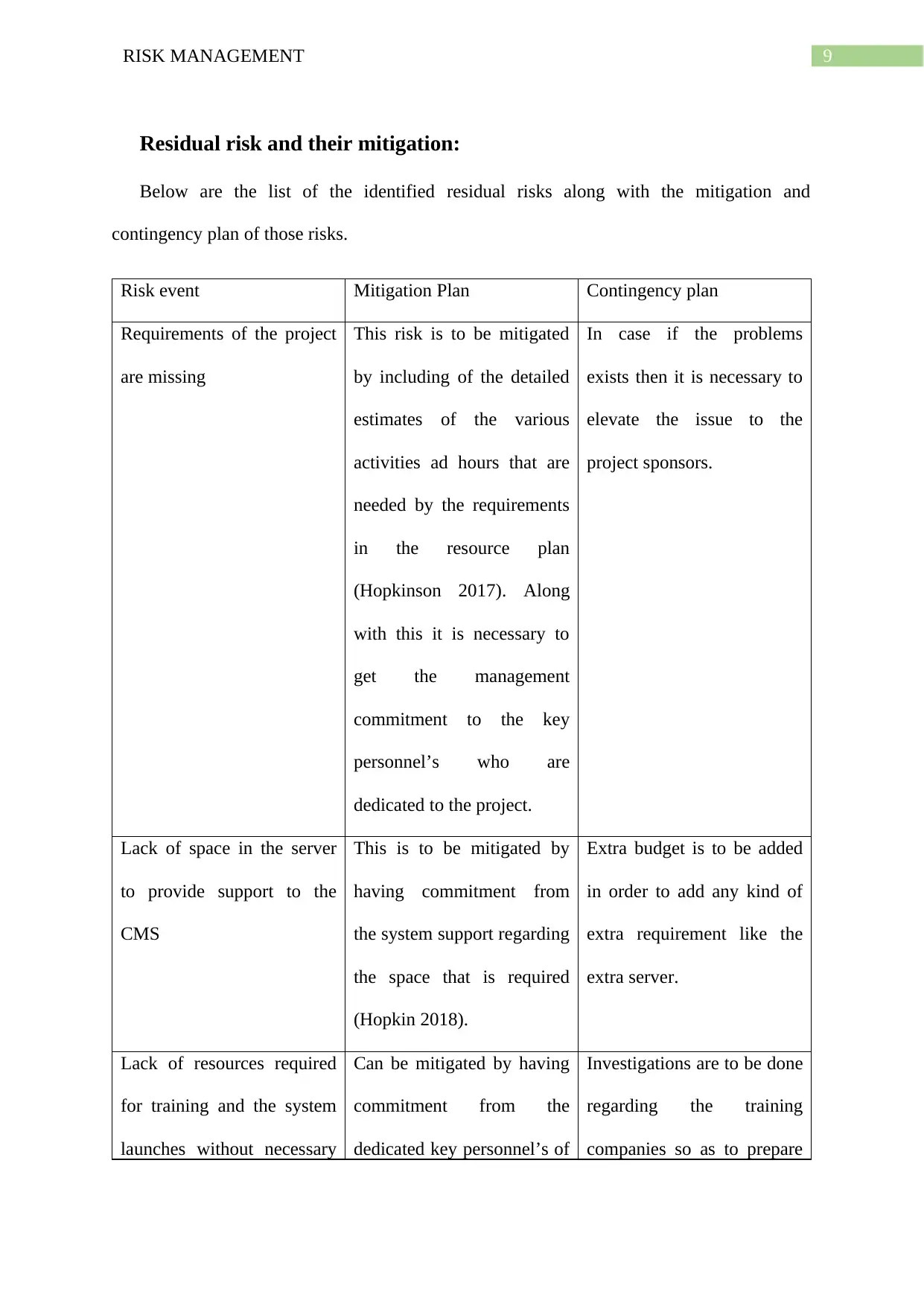
9RISK MANAGEMENT
Residual risk and their mitigation:
Below are the list of the identified residual risks along with the mitigation and
contingency plan of those risks.
Risk event Mitigation Plan Contingency plan
Requirements of the project
are missing
This risk is to be mitigated
by including of the detailed
estimates of the various
activities ad hours that are
needed by the requirements
in the resource plan
(Hopkinson 2017). Along
with this it is necessary to
get the management
commitment to the key
personnel’s who are
dedicated to the project.
In case if the problems
exists then it is necessary to
elevate the issue to the
project sponsors.
Lack of space in the server
to provide support to the
CMS
This is to be mitigated by
having commitment from
the system support regarding
the space that is required
(Hopkin 2018).
Extra budget is to be added
in order to add any kind of
extra requirement like the
extra server.
Lack of resources required
for training and the system
launches without necessary
Can be mitigated by having
commitment from the
dedicated key personnel’s of
Investigations are to be done
regarding the training
companies so as to prepare
Residual risk and their mitigation:
Below are the list of the identified residual risks along with the mitigation and
contingency plan of those risks.
Risk event Mitigation Plan Contingency plan
Requirements of the project
are missing
This risk is to be mitigated
by including of the detailed
estimates of the various
activities ad hours that are
needed by the requirements
in the resource plan
(Hopkinson 2017). Along
with this it is necessary to
get the management
commitment to the key
personnel’s who are
dedicated to the project.
In case if the problems
exists then it is necessary to
elevate the issue to the
project sponsors.
Lack of space in the server
to provide support to the
CMS
This is to be mitigated by
having commitment from
the system support regarding
the space that is required
(Hopkin 2018).
Extra budget is to be added
in order to add any kind of
extra requirement like the
extra server.
Lack of resources required
for training and the system
launches without necessary
Can be mitigated by having
commitment from the
dedicated key personnel’s of
Investigations are to be done
regarding the training
companies so as to prepare
Paraphrase This Document
Need a fresh take? Get an instant paraphrase of this document with our AI Paraphraser
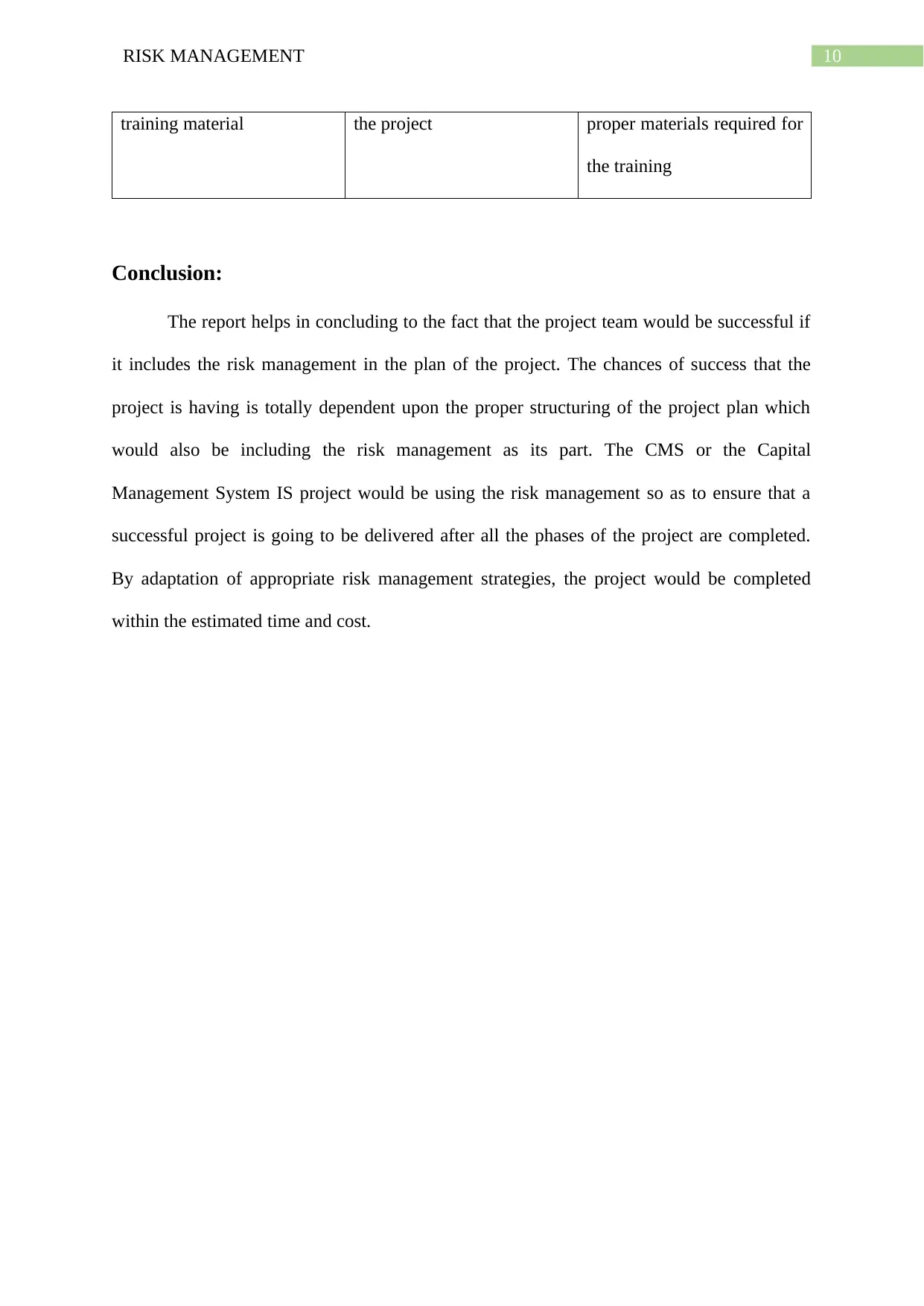
10RISK MANAGEMENT
training material the project proper materials required for
the training
Conclusion:
The report helps in concluding to the fact that the project team would be successful if
it includes the risk management in the plan of the project. The chances of success that the
project is having is totally dependent upon the proper structuring of the project plan which
would also be including the risk management as its part. The CMS or the Capital
Management System IS project would be using the risk management so as to ensure that a
successful project is going to be delivered after all the phases of the project are completed.
By adaptation of appropriate risk management strategies, the project would be completed
within the estimated time and cost.
training material the project proper materials required for
the training
Conclusion:
The report helps in concluding to the fact that the project team would be successful if
it includes the risk management in the plan of the project. The chances of success that the
project is having is totally dependent upon the proper structuring of the project plan which
would also be including the risk management as its part. The CMS or the Capital
Management System IS project would be using the risk management so as to ensure that a
successful project is going to be delivered after all the phases of the project are completed.
By adaptation of appropriate risk management strategies, the project would be completed
within the estimated time and cost.
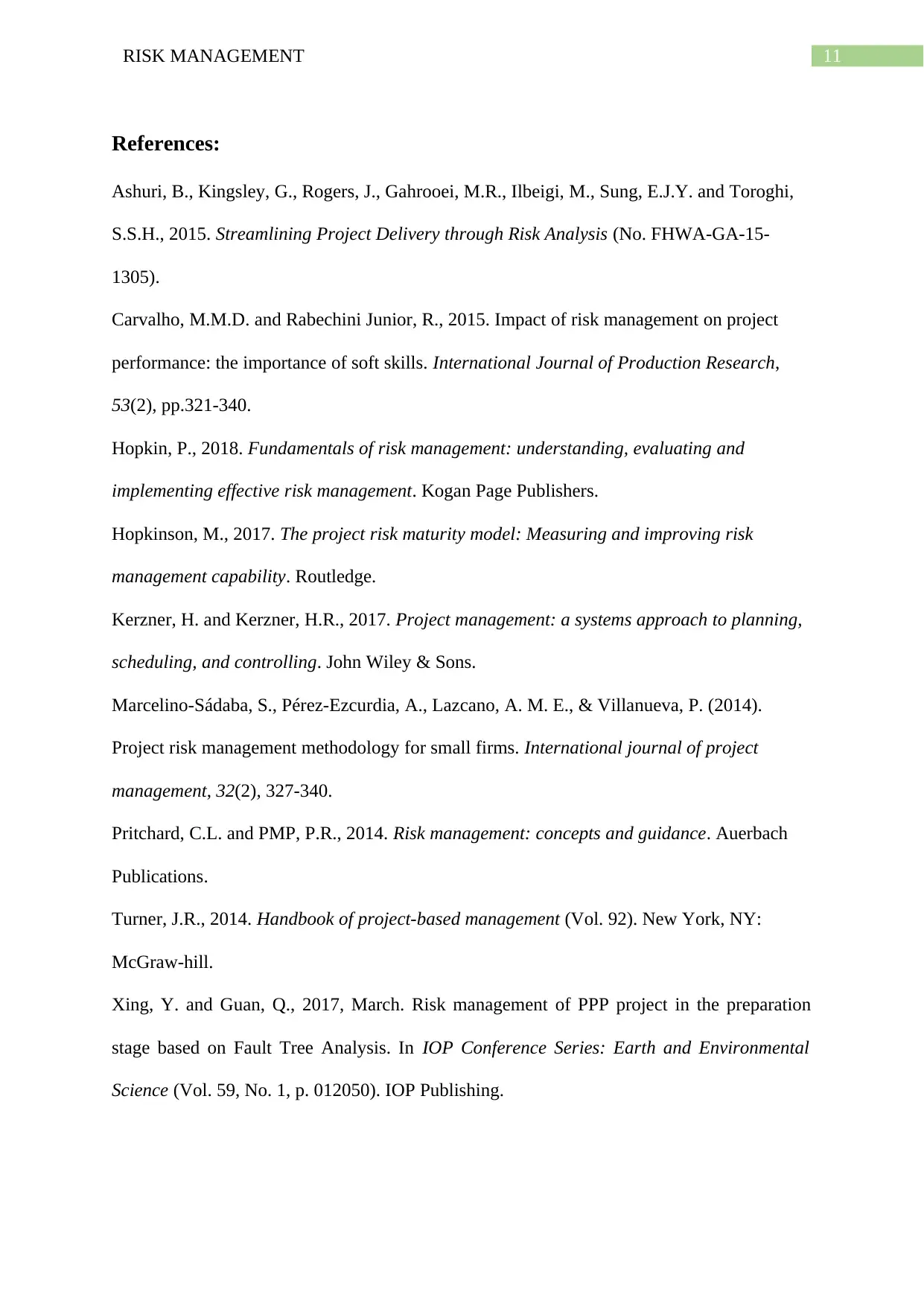
11RISK MANAGEMENT
References:
Ashuri, B., Kingsley, G., Rogers, J., Gahrooei, M.R., Ilbeigi, M., Sung, E.J.Y. and Toroghi,
S.S.H., 2015. Streamlining Project Delivery through Risk Analysis (No. FHWA-GA-15-
1305).
Carvalho, M.M.D. and Rabechini Junior, R., 2015. Impact of risk management on project
performance: the importance of soft skills. International Journal of Production Research,
53(2), pp.321-340.
Hopkin, P., 2018. Fundamentals of risk management: understanding, evaluating and
implementing effective risk management. Kogan Page Publishers.
Hopkinson, M., 2017. The project risk maturity model: Measuring and improving risk
management capability. Routledge.
Kerzner, H. and Kerzner, H.R., 2017. Project management: a systems approach to planning,
scheduling, and controlling. John Wiley & Sons.
Marcelino-Sádaba, S., Pérez-Ezcurdia, A., Lazcano, A. M. E., & Villanueva, P. (2014).
Project risk management methodology for small firms. International journal of project
management, 32(2), 327-340.
Pritchard, C.L. and PMP, P.R., 2014. Risk management: concepts and guidance. Auerbach
Publications.
Turner, J.R., 2014. Handbook of project-based management (Vol. 92). New York, NY:
McGraw-hill.
Xing, Y. and Guan, Q., 2017, March. Risk management of PPP project in the preparation
stage based on Fault Tree Analysis. In IOP Conference Series: Earth and Environmental
Science (Vol. 59, No. 1, p. 012050). IOP Publishing.
References:
Ashuri, B., Kingsley, G., Rogers, J., Gahrooei, M.R., Ilbeigi, M., Sung, E.J.Y. and Toroghi,
S.S.H., 2015. Streamlining Project Delivery through Risk Analysis (No. FHWA-GA-15-
1305).
Carvalho, M.M.D. and Rabechini Junior, R., 2015. Impact of risk management on project
performance: the importance of soft skills. International Journal of Production Research,
53(2), pp.321-340.
Hopkin, P., 2018. Fundamentals of risk management: understanding, evaluating and
implementing effective risk management. Kogan Page Publishers.
Hopkinson, M., 2017. The project risk maturity model: Measuring and improving risk
management capability. Routledge.
Kerzner, H. and Kerzner, H.R., 2017. Project management: a systems approach to planning,
scheduling, and controlling. John Wiley & Sons.
Marcelino-Sádaba, S., Pérez-Ezcurdia, A., Lazcano, A. M. E., & Villanueva, P. (2014).
Project risk management methodology for small firms. International journal of project
management, 32(2), 327-340.
Pritchard, C.L. and PMP, P.R., 2014. Risk management: concepts and guidance. Auerbach
Publications.
Turner, J.R., 2014. Handbook of project-based management (Vol. 92). New York, NY:
McGraw-hill.
Xing, Y. and Guan, Q., 2017, March. Risk management of PPP project in the preparation
stage based on Fault Tree Analysis. In IOP Conference Series: Earth and Environmental
Science (Vol. 59, No. 1, p. 012050). IOP Publishing.
⊘ This is a preview!⊘
Do you want full access?
Subscribe today to unlock all pages.

Trusted by 1+ million students worldwide
1 out of 12
Related Documents
Your All-in-One AI-Powered Toolkit for Academic Success.
+13062052269
info@desklib.com
Available 24*7 on WhatsApp / Email
![[object Object]](/_next/static/media/star-bottom.7253800d.svg)
Unlock your academic potential
Copyright © 2020–2025 A2Z Services. All Rights Reserved. Developed and managed by ZUCOL.



